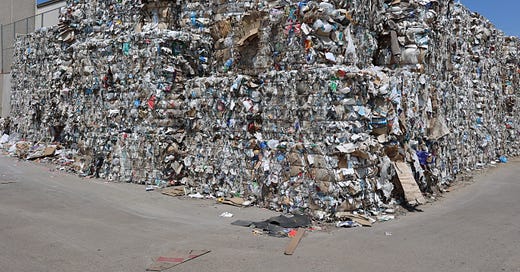City Hall trying to get handle on falling recycling rates in Sioux Falls
Public Works Department launches public education campaign
Dwindling recycling rates in Sioux Falls have City Hall launching a new public education campaign in hopes of keeping more refuse out of the city landfill.
The Sioux Falls Public Works Department Tuesday announced that it's sending postcards, developing educational materials for garbage haulers to share with customers, and conducting meetings with property owners throughout the city in hopes of curbing a upward trend in the amount of recyclable garbage ending up at the dump.
“Over the years we've seen great progress in recycling, specifically residential recycling has been a really consistent clean stream of recycling,” Public Works Director Mark Cotter said at a morning news conference. “On the other hand, we've seen an overall steady decrease in recycling.”
NEWS: As area population grows, recycling rate falls
Cotter was referring to recycling rates tracked annually by the city and its 16 licensed garbage haulers that show just 18.7 percent of waste being collected is being diverted from the landfill. That's down from a recycling rate of more than 23 percent reported between 2015 and 2018.
Nationally, the average is more than 30 percent.
According to findings of a Solid Waste Planning Board task force on recycling formed last year, a primary driver of the decline is an increase in the number of multi-unit housing complexes in the five-county region that use the landfill. A lack of understanding about recycling best practices among area residents is also why recyclable materials are often ending up in the landfill as well, according to the task force.
That's why the public education campaign being undertaken by City Hall aims to inform residents, property owners, and building managers how best to go about recycling, said Holly Meier, Sioux Falls Sustainability Coordinator.
Meier said too many are still bagging their recyclables, which results in those materials all ending up in the landfill. Mixing non-recyclables with recyclables is also holding recycling rates down, she said.
“At multifamily housing and commercial properties, contamination is frequent considering the number of individuals interacting with one bin,” Meier said. “Contamination causes problems and can increase fees for the recycling facility, for haulers, and ultimately the customer.”
Meier said industry best practices require that recyclables be unbagged and loose in the recycling bin when they're collected by their garbage hauler.
Cotter said keeping recyclable material out of the landfill also comes with a financial benefit for the community. That's because space at the facility west of Sioux Falls is finite, he said.
“Operating and maintaining a landfill, it's an expensive business,” Cotter said, noting the complex is at about half of its capacity right now, and the cost of permitting more space would cost tens of millions of dollars. “When we think about maximizing the airspace in the landfill, recycling to the fullest extent, diverting those reusable materials away — we're extending the life of the landfill and also preserving our natural environment and ultimately resulting in very stable collection costs for our landfill customers.”












I feel that continued information and education campaign year round is needed to get us to the national average of 30%
Trash collection in Sioux Falls needs to be much more well thought out. In any given neighborhood, there's multiple companies' trucks driving all around multiple days each week. Divide the city into viable routes, take multiple bids, keeping many businesses going. Alongside this, develop sound recycling practices and reach out to households via the collection efforts. We all have trash, some can be recycled, and it is a valuable and viable business practice. Not to mention we could do our part to reduce waste.